Adrian Collins's Blog, page 119
October 21, 2022
REVIEW: Saturnalia by Stephanie Feldman
The slow-motion collapse of modern civilization is reason to party in Saturnalia, the new sci-fi horror by Stephanie Feldman, which takes place in a near-future Philadelphia amid growing climate disaster. As the world gradually succumbs to increasingly severe hurricanes, droughts, and killer mosquitos, the newly paganized City of Brotherly Love lets loose with Saturnalia, the riotous multi-day celebration of the winter solstice honoring the Roman god of abundance.
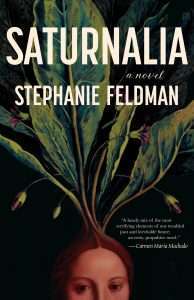 The protagonist of the story, Nina, is a tarot card reader formerly associated with the prestigious Saturn Club, the go-to venue for Philadelphia’s elite society and a thinly veiled center for alchemical experiments and other occultist practices. Nina knows that her fortunetelling is rubbish, but her cards may reveal more truth than she realizes.
The protagonist of the story, Nina, is a tarot card reader formerly associated with the prestigious Saturn Club, the go-to venue for Philadelphia’s elite society and a thinly veiled center for alchemical experiments and other occultist practices. Nina knows that her fortunetelling is rubbish, but her cards may reveal more truth than she realizes.
The plot of Saturnalia focuses on Nina’s attempts to infiltrate her former club and unravel its mysteries. Nina finds the perfect opportunity to sneak into the Saturn Club unnoticed during its masquerade party, which opens the winter solstice celebration. Nina deftly navigates the labyrinthine club and discovers the horrifying secret lying beneath the façade of the Saturn Club’s debauchery.
Stephanie Feldman’s writing perfectly captures the disorienting feel of Nina’s experiences both in and out of the Saturn Club. Reading Saturnalia feels like a fever dream, full of discordant imagery that draws the reader into this hedonistic world and its bizarre social order. Combined with its nonlinear narrative structure, the novel has a disorienting quality that accurately portrays the chaos of a young woman just trying to live her best life amidst a world of apocalyptic revelry.
As a resident of Pennsylvania, I particularly enjoyed Feldman’s choice of her native Philadelphia as the setting for the novel, which is filled with references to local geography and culture. The juxtaposition of Pennsylvania’s Quaker roots with its recent embrace of paganism is particularly well done in Saturnalia.
There are many compelling facets to Saturnalia, particularly its feverish storytelling as we gradually put together the pieces of Nina’s backstory and learn the truth of the Saturn Club. Still, the plot never really takes off to the full extent I was anticipating. I was hoping for more layers to the Saturn Club’s mysteries and greater insights into the people behind the club itself.
Overall, Saturnalia offers a unique take on an apocalyptic future, striking a good balance between elements of sci-fi and horror while warning of the social impact of our impending ecological disaster.
4/5
Read Saturnalia by Stephanie FeldmanThe post REVIEW: Saturnalia by Stephanie Feldman appeared first on Grimdark Magazine.
October 20, 2022
REVIEW: Plague War By Guy Haley
In the follow up to Dark Imperium, Guy Haley’s Plague War tells the story of the Indomitus Crusade’s war to throw the the Traitor Primarch Mortarion and his Death Guard legions out of Ultramar’s five-hundred worlds. In my review of book one in this series, I was critical of what I saw as a rushed, missed opportunity to bring new readers into the 40k fold. I am really happy to say that with book two, Haley has steadied the ship and is driving us towards what should be a really fun trilogy.
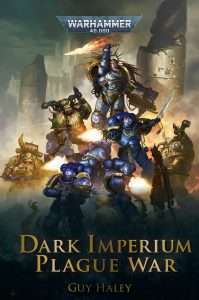 The most interesting aspect of the story is the fight to turn the god-like Primarch Roboute Guilliman into a believer of the Imperial Cult (which, in turn, believes he and his father to be gods). It’s one of the clearest juxtapositions between the Warhammer 30k and 40k storylines, and Haley delves into the topic with aplomb. I loved the way it shows the internal idealogical war within the crusade and how that represents that of the wider imperium.
The most interesting aspect of the story is the fight to turn the god-like Primarch Roboute Guilliman into a believer of the Imperial Cult (which, in turn, believes he and his father to be gods). It’s one of the clearest juxtapositions between the Warhammer 30k and 40k storylines, and Haley delves into the topic with aplomb. I loved the way it shows the internal idealogical war within the crusade and how that represents that of the wider imperium.
The story focus on Guilliman’s traitor brother Mortarion and his Nurgle allies is much less in this book, and those sections that are included feel far more relevant than book one. Plague War is far better for it. Where in book one they tended to be superfluous, at times confusing, and seemed to lead nowhere between the front and back cover, this time they were on point and drove the story forward. Haley’s ability to write the Nurgle scenes with such filth and disgust, but such understanding of what Nurgle is (life, death, rebirth) is awesome to behold. To me, those scenes never got stale, though he did make me want to puke a few times!
Something else Haley absolutely knocked out of the park in Plague War was his nods to the awesome characters of the Warhammer 40,000 universe. There were plenty of mentions of epic champions and traitorous villains, including to those from the Horus Heresy era. Plague War focussed on using the right cast at the right time to tell the story, and it was a brilliant read for it.
Overall, Plague War is a drastic improvement on Dark Imperium. The people of the Indomitus Crusade are starting to be stretched thin both physically and ideologically, and the being they see as a god is becoming less and less happy about it. It’s a damned good book two and I can’t wait to get stuck into book three.
Read Plague War by Guy HaleyThe post REVIEW: Plague War By Guy Haley appeared first on Grimdark Magazine.
October 19, 2022
REVIEW: The Grief of Stones by Katherine Addison
The Grief of Stones by Katherine Addison is the second book of the Cemeteries of Amalo series, a spin-off of The Goblin Emperor. This book, like Witness for the Dead, follows the prelate Thara Celahar as he works through petitions to speak, or witness for, the dead. He can do this because he is able to ‘feel’ the presence of the departed as long as the soul lingers in the body. In trying to witness, he often has to interrogate people, follow leads, and look for clues, which makes The Grief of Stones feel like a fantasy take on a police procedural.
“On a cloudy autumn day, I attended the execution of Broset Sheveldar.”
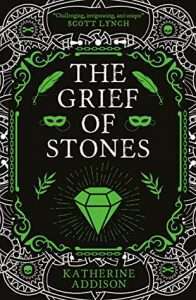 The story is told from Thara Celahar’s perspective, which gives us important insight into a character who must be hard to read for those not privy to his thoughts. Thara has many petitions throughout The Grief of Stones, but the overarching petition involves the death of an orphan girl who was murdered and has no one to speak for her or even claim that they had any relation to her. Her death reveals several threads that show a dark underbelly of Amalo that was not apparent in the Witness for the Dead. In terms of character growth, Thara combats some of the darkest parts of himself and, dare I say, even allows himself to be happy, now and again, despite his many regrets and losses. This is all in addition to Thara taking on the role of mentor for a Witness for the Dead in training named Othalo Tomasin. This dynamic shows different facets of Thara’s character, and even the kindness that he often hides come out a bit more in The Grief of Stones through the interactions he has with Othalo Tomasin.
The story is told from Thara Celahar’s perspective, which gives us important insight into a character who must be hard to read for those not privy to his thoughts. Thara has many petitions throughout The Grief of Stones, but the overarching petition involves the death of an orphan girl who was murdered and has no one to speak for her or even claim that they had any relation to her. Her death reveals several threads that show a dark underbelly of Amalo that was not apparent in the Witness for the Dead. In terms of character growth, Thara combats some of the darkest parts of himself and, dare I say, even allows himself to be happy, now and again, despite his many regrets and losses. This is all in addition to Thara taking on the role of mentor for a Witness for the Dead in training named Othalo Tomasin. This dynamic shows different facets of Thara’s character, and even the kindness that he often hides come out a bit more in The Grief of Stones through the interactions he has with Othalo Tomasin.
“I emerged from the confines of the Ulzhavadeise compound into the teeth of a bitter wind.”
Katherine Addison’s prose in The Grief of Stones is strong and concise, yet the strongest point of her writing is definitely in the world-building. The religion, the races, and Amalo itself are all wonderfully realized in such a way that few other authors are able to do. I felt a connection to the city because the author made it feel like a real place, a character all its own.
“I slept patchily that night and woke to an overcast dawn; the light was gray and thin.”
The Grief of Stones is a fantastic novel that excels in its world-building. It will appeal to fans of fantasy and crime novels and is an improvement over the previous book of the series (which was also very good). I can wholeheartedly recommend this book and I give it 5 out of 5 stars.
Read The Grief of Stones by Katherine AddisonThe post REVIEW: The Grief of Stones by Katherine Addison appeared first on Grimdark Magazine.
REVIEW: House of the Dragon-Episode 9 ‘The Green Council’
The penultimate episodes of each season of Game of Thrones would often be the most talked about episodes – think of Blackwater, Battle of the Bastards, Baelor (I still miss Ned), and The Rains of Castamere. House of the Dragon E9 doesn’t reach those dizzy heights. Instead, it delivers a solid, if plodding episode with a grand finish.
House of the Dragon E9 is all about the fallout of Visery’s final words to Alicent and the way in which she has interpreted them. The small council reveal that they have been preparing to claim that Alicent’s son Aegon is the next in line to the Iron Throne and although Alicent seems shocked, only poor Lord Lyman Beesbury voices his discomfort in such an act. The response from Criston Cole is to slam his head into the table, killing the one person objecting to the madness. It’s another sign of Cole’s descent throughout the season but whether it is the acting or the way his story has played out, Cole’s time on screen often leaves me perplexed and hoping for a grisly death for the knight. A rare weak point for the show. Of course, with Aegon now basically an uncrowned king, he has gone missing. Both Otto and Alicent send their people to track him down, allowing us a bit of time to enjoy the brilliant Prince Aemond who is fast becoming one of the most interesting characters in the series. The journey through Flea Bottom also gives the audience a chance to see how sick and twisted the soon-to-be king is, with him often attending brutal child fighting pits and even fathering his own bastards and leaving them to the hell of the pit. It shows the hypocrisy of the Greens who have fought against both Rhaenyra and Daemon being heir due to supposed lack of morals. We’ve gone from Otto, Alicent, and Cole wanting to protect the realm from the depravity of Rhaenyra and her uncle, to a king who loves child torture, Larys Strong who loves feet (I won’t explain), and Cole who loves… no idea to be honest. I think he just loves anything that will make Rhaenyra suffer after their little fling. The Greens are easy to hate, even though in Fire and Blood, the balance of depravity is shared more equally between the sides.
The star of House of the Dragon E9 is Rhaenys. The Queen Who Never Was spends much of the episode locked in her room as Alicent and the Greens attempt to control those in King’s Landing as they search for Aegon. She is an important piece on the board – a dragon rider respected by all and mother of children who will inherit control of the sea. Rhaenys feels like the character who understands more than anyone else the importance of the Iron Throne and the way in which many of the major players are trapped, especially the women in the show, even as they fight against it. She has one goal in the episode as the Greens rush to crown the petulant Aegon and that is to find her dragon. It leads to one of the best endings to any of the episodes set in Martin’s world and gives us the final piece needed as we head into what will be an explosive finale next week. There are little nods to what will be the future of Westeros with a network of spies gathering information around the city, more signs of the Seven, and the importance of bastards when dealing with the Iron Throne. Speaking of the future, everything poor Helaena Targaryen seems to say of late appears to be a prophecy so it will be interesting to see how things develop based on her few lines in each episode.
House of the Dragon E9 isn’t the best episode of the series but it does what it needs to do to set things up for the finish. The Greens and the Blacks are where they need to be and the battle for the Iron Throne is about to begin. A slow episode that gives way to a roaring finish. Let battle commence!
The post REVIEW: House of the Dragon-Episode 9 ‘The Green Council’ appeared first on Grimdark Magazine.
October 18, 2022
September 2022 comic book round up!
September was a hell of a month for comics. Busy, totally packed with lots of amazing titles that really went straight for the heart. It was hard to narrow it down to just the really solid handful we have here when there were so many books amazing our, but these are the ones that really stood out from the pack.
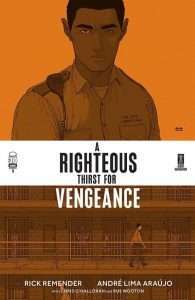 A Righteous Thirst For Vengeance #11 (IMAGE)Rick Remender (W), Andres Lima Araujo (A)
A Righteous Thirst For Vengeance #11 (IMAGE)Rick Remender (W), Andres Lima Araujo (A)The final issue to what has, quite possibly, been one of the strongest titles on the stands in 2022, A Righteous Thirst For Vengeance takes a massive leap forward in time and ties the entire story together in a brilliant, brutal, heart-wrenching, gut-punching finale. Remender consistently delivers on unflinching narratives that rip the reader apart, and Araujo’s art—cinematic and inspired—presents the story in a way that’s impossible to look away from. It’s all the more impressive because A Righteous Thirst For Vengeance plays out with a limited amount of dialogue which only serves to punctuate the action and the moments when the characters interact verbally.
The previous issue was a knife to the heart that left behind an ugly, puckered scar, but with the end of A Righteous Thirst For Vengeance we get closure and an ending that lands absolutely perfectly. Also, I’ve been saying this since the first issue, but I would not be even a little bit surprised if in the next year or so A Righteous Thirst For Vengeance gets optioned for a show or movie. It’s that good. And deserves it.
Read A Righteous Thirst For Vengeance #11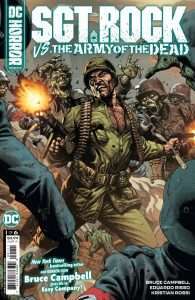 Sgt. Rock vs The Army of the Dead #1 (DC)Bruce Campbell (W), Eduardo Risso (A)
Sgt. Rock vs The Army of the Dead #1 (DC)Bruce Campbell (W), Eduardo Risso (A)Who do you call if you want to make a comic book about killing Nazi zombies and make it a scathingly unapologetic romp through some of the worst moments of World War 2 but still have it be a goddamn good time?
Bruce Campbell, obviously.
And Bruce totally nails it. Sgt. Rock vs The Army of the Dead is a thrill-a-minute splatterfest that throws you right into the trenches with Sargeant Rock and Easy Company as they face off against Hitler’s army of undead super soldiers. It’s gory, grotesque, and fun as hell. Cannot recommend it enough, and with issue one it’s the perfect time to get in on the action.
Read Sgt. Rock vs The Army of the Dead #1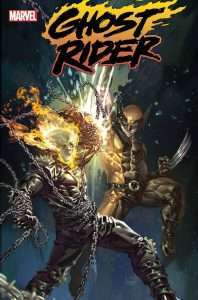 Ghost Rider #6 (MARVEL)Benjamin Percy (W), Brent Peeples (A)
Ghost Rider #6 (MARVEL)Benjamin Percy (W), Brent Peeples (A)Full disclosure, I was kind of on the fence when I heard there was going to be a new Ghost Rider series coming out in 2022 written by Benjamin Percy. It’s not that I don’t think the guy can write, I just haven’t been the biggest fan of most his stories in recent years. But I am an unapologetically giant Ghost Rider nerd and I’m glad I gave the new series a chance because it is one hell of a ride—pun whole-heartedly intended.
Taking it back to its horror roots, Percy gives us a Ghost Rider at his most fragile and possibly most unhinged, and in issue six we get to see an exorcism orchestrated by Wolverine. Because everyone loves Wolverine (and Percy happens to write that book, too), but it works out. It certainly doesn’t hurt that the art is totally rad, utterly gruesome, and impossible to look away from. A great series.
Read Ghost Rider #6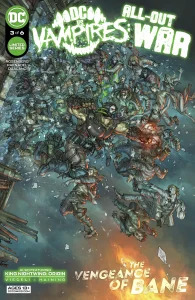 DC vs Vampires: All Out War #3 (DC)Matthew Rosenberg (W), Alex Paknadel (W), Emma Vieceli (W), Pasquale Qualano (A)
DC vs Vampires: All Out War #3 (DC)Matthew Rosenberg (W), Alex Paknadel (W), Emma Vieceli (W), Pasquale Qualano (A)Tying in to the main, on-going DC vs Vampires title, All Out War tells the story of a covert band of super powered operatives on a desperate mission to upend the undead status quo and all their victories and tragedies—and their tragedies are numerous. It’s one of the most brutal books DC has put out in a long time, serving up equal parts ultra violence and heartbreak, betrayals and bloodletting. And they do it to an absolutely awesome effect by having the book predominantly delivered in grayscale but punctuated by reds. It’s very, very cool.
You don’t really have to have a functional knowledge of the primary series to get into All Out War, either, it works very well as a standalone story. To be honest, the only problem I have with it is that the book feels like it goes by so damn fast I’m left with my head spinning and upset that I have to wait a whole damn month for the next issue.
Read DC vs Vampires: All Out War #3 007 #2 (DYNAMITE)
007 #2 (DYNAMITE)
Phillip Kennedy Johnson (W), Marco Finnegan (A)
003 has been killed and James Bond mourns her death after he realizes he very likely got her assassinated by the Myrmidon organization. Bond is still in a fugue over the fact that he no longer feels he can trust MI6 and has taken the very Fleming-esque view he’s going to end up in a ditch for people he doesn’t respect. Fleming always had Bond on the cusp of quitting or believing hat he was going to die in the line of duty, which this Bond certainly feels like as well. We also get more information on 003 that probably would have been better spent before she was killed. Myrmidon is just another evil organization, in this case a PMC that has no allegiance to anyone (which seems like bad business), but I’m interested in seeing where they go with it.
Read 007 #2The post September 2022 comic book round up! appeared first on Grimdark Magazine.
October 17, 2022
Another Eight Indie Cyberpunk Novel Recommendations
Cyberpunk as a genre arguably hit its heyday during the Eighties as a cultural force with Neuromancer and reached its zentih in social acceptance in the Nineties with The Matrix movies. After that, it slowly tapered off and ceased to be something fans got hyped over barring a few high profile video games. This is due to my suspicion that cyberpunk slowly became reality, or at least so similar to our current era of big corporations and hacker criminals that it stopped becoming genre fiction.
There have been a few major successes since then, literature-speaking, though as well as some genuine artistic achievements. Altered Carbon is one of the strongest entries into this series due to Richard K. Morgan reinventing the darkness and anger of the original works for the Twenty First Century. However, there’s not nearly as many peers to it as there should be and the big corporate produced cyberpunk novels are not what I’m here to discuss.
No, I’m here to discuss indie produced cyberpunk novels that have caught my eye over the past decade and ones that I think are worth recommending. As a cyberpunk author myself with the Agent G and Cyber Dragons trilogies, I thought I’d share eight novels that I really enjoyed set in the cyberpunk genre.
What is cyberpunk? For the purposes of this list, I’m going to define it as gritty near-future science fiction with an anti-authoritarian bent. For me, you can’t claim the title of “punk” unless you have the latter, which is why The Matrix qualifies even if it’s in the far future. You’re welcome to disagree with the definition but that should let you know what I’m recommending down here.
You can find my previous indie cyberpunk recommendations here.
You Can Be a Cyborg When You’re Older by Richard Roberts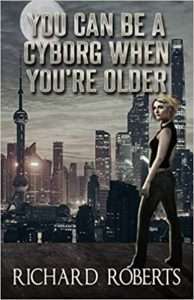
Synopsis: In the bleak future of West Angel City, Vanity Rose is having a great time. She has a loving robot caretaker, a fake elf for a sister, and she roams the walls of West Angel’s endless skyscrapers every night, thanks to her precious gravity shoes.
What Vanity doesn’t have are money and adventure, but she has a plan to get both. She’s going to walk the dark side, joining the thieves and mercenaries who get paid to do all the little jobs that make a corrupt city go around. She’ll only have to deal with killer robots, vengeance-crazed and not very bright computer programs, cyborg vampires, telepathic capybaras, mean girl mech pilots, and have every homemade weapon in the city pointed at her. Fourteen is old enough for that, right?
Recommendation: I’m already shooting myself in the foot by making this my first entry but this is a Young Adult novel cyberpunk parody by the author of the Please Don’t Tell My Parents I’m a Supervillain series. It’s a wild and bizarre world where a good chunk of the population has joined a transhumanist cult where you spend all your money transforming yourself into World of Warcraft characters.
Read You Can Be a Cyborg When You’re Older by Richard RobertsTen Sigma by A.W. Wang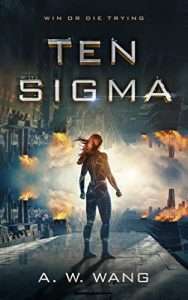 Synopsis: In future America, the downloaded people in the Ten Sigma Program fight endless battles. The struggles span all possibilities: face-offs with knives and clubs, skirmishes as Roman legionaries, pitched WW1 trench warfare, duels with ultra-modern hypersonic weapons, and everything in between. The combatants who live are rewarded with another battle until they reach the unreachable score of ten sigmas. Those who die are expunged from the system, gone forever. The methods, so harsh they go beyond anything possible in the real world, are necessary for the end goal: violent evolution to produce the greatest warriors in all of human history.
Synopsis: In future America, the downloaded people in the Ten Sigma Program fight endless battles. The struggles span all possibilities: face-offs with knives and clubs, skirmishes as Roman legionaries, pitched WW1 trench warfare, duels with ultra-modern hypersonic weapons, and everything in between. The combatants who live are rewarded with another battle until they reach the unreachable score of ten sigmas. Those who die are expunged from the system, gone forever. The methods, so harsh they go beyond anything possible in the real world, are necessary for the end goal: violent evolution to produce the greatest warriors in all of human history.
Who would choose such a fate? Those with no hope. On a wintry night, a government representative presents Mary, who is dying of incurable cancer, with the offer: a second chance at life and for those completing the requirements, a return to the real world in a fresh, healthy body. To save her family from bankrupting medical bills, she accepts. After her consciousness is transferred into the virtual universe of the program, her essence is ripped apart and her memories shattered. She’s reassembled as the perfect killer.
As the life-and-death contests begin, she discovers the true nature of what lies ahead. But, she won’t surrender to the impossible and grimly embarks on the journey to return to her family while trying to save her soul.
Recommendation: Ten Sigma is an interesting story with the premise of a dying woman signing her consciousness over to the US government to be horrifically brutalized and reprogrammed into becoming a killing machine they will unleash after the imminent collapse of society. This is a fascinating story because it almost entirely takes place in a virtual battlefield and is all about the dehumanizing effect of the training as well as the goal to eliminate every bit of humanity from the woman inside. You know, fun stuff like that. I liked it but it’s a harsh read.
Read Ten Sigma by A.W. WangPsychodrome by Simon Hawke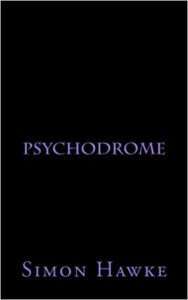 Synopsis: Fresh out of the service, Arkady O’Toole decides to celebrate with a gambling spree on the Ginza Strip of Tokyo. He winds up in a game of high stakes poker with some heavy duty players and makes one very big mistake — he wins. The man he takes down for a bundle turns out to be a warlord of the Yakuza and Hakim Saqqara doesn’t like to lose.
Synopsis: Fresh out of the service, Arkady O’Toole decides to celebrate with a gambling spree on the Ginza Strip of Tokyo. He winds up in a game of high stakes poker with some heavy duty players and makes one very big mistake — he wins. The man he takes down for a bundle turns out to be a warlord of the Yakuza and Hakim Saqqara doesn’t like to lose.
Trying to escape Saqqara’s vengeance, O’Toole enters Psychodrome, the ultimate reality game show, where the audience can link up and access the thoughts and feelings of the players as they compete in an intergalactic scavenger hut where reality blurs with computer simulation and winning could make a player rich … or it could make him dead.
And as if that wasn’t challenging enough, O’Toole discovers that Saqqara’s ninja assassins have followed him into the game ….
Recommendation: This may be cheating but Psychodrome is a fantastic cyberpunk novel that has moved from traditional publishing to independent. It’s a great story of a Running Man-esque reality TV show that our protagonist finds himself on.
Read Psychodrome by Simon HawkeThe Blind Spot by Michael Robertson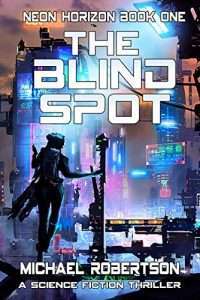 Synopsis: Would you betray everyone you cared about to prevent a war?
Synopsis: Would you betray everyone you cared about to prevent a war?
Marcie Hugo isn’t a typical sixteen-year-old. She’s been cybernetically enhanced to have superhuman strength, speed, and judgement. For what it’s worth. She’s lived her entire life in the Blind Spot; a garish neon rat run of debauchery. Since her mum’s murder several years ago, her dad’s method for keeping her safe has been to imprison her in her own home. But with her sixteenth birthday looming, she’s going to start making her own life choices. She’ll finally move away to the neighbouring Scala City with the boy she loves.
But when a terrorist attack raises the temperate of the cold war between the Blind Spot and the city, her vision of her planned future begins to fade. If she’s to put her bad memories and the home she hates behind her, she has to act.
With time running out and tensions rising, Marcie finds herself as the only person who can prevent the conflict. But it comes at a cost. Does she betray everyone she cares about and sacrifice her chances with her one true love, or does she let thousands die in a preventable war? Join Marcie as she tears through dystopian cityscapes and neon flooded alleyways in an attempt to put all the pieces into place to prevent a war that could kill everyone.
Recommendation: In the future, the majority of humanity has relocated to city-states in the middle of large wastelands and farms. One city is divided into the corporate-run have’s while the have-nots actually have done pretty well for themselves by keeping a monopoly on vice as well as transhumanist technologies. However, the careful truce between the two sides is disrupted when someone starts framing the latter for terrorist activities against the former. Unless it’s not a frame job at all. Our badass cyber-heroine and a very bland corporate douche must find out.
Read The Blind Spot by Michael RobertsonThe Machine Killer by D.L. Young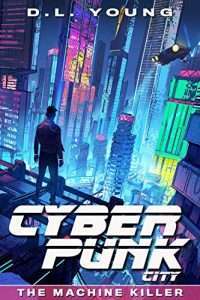 Synopsis: A notorious data thief thinks his life of cybercrime is behind him. He couldn’t be more wrong. Forced by a powerful executive to steal a priceless dataset, Blackburn Maddox uncovers the shocking truth of a secret war between AIs, raging inside the digital universe known as virtual space. Plunged headlong into the deadly conflict, he’ll have to use every trick he’s ever learned—and a few he’s never tried before—if he wants to survive. If you love gritty, near-future scifi, you won’t want to miss this series!
Synopsis: A notorious data thief thinks his life of cybercrime is behind him. He couldn’t be more wrong. Forced by a powerful executive to steal a priceless dataset, Blackburn Maddox uncovers the shocking truth of a secret war between AIs, raging inside the digital universe known as virtual space. Plunged headlong into the deadly conflict, he’ll have to use every trick he’s ever learned—and a few he’s never tried before—if he wants to survive. If you love gritty, near-future scifi, you won’t want to miss this series!
Recommendation: Blackburn Maddox is a hacker with a decent job at a legitimate corporation. He should have known it was too good to be true. It turns out his employers hired an ex-con in hopes of getting him to do a heist for them and he’ll lose his awesome new job if he doesn’t cooperate. Hooking up with an annoying kid, a treacherous fence, and a beautiful combat cyborg–the heist is just the beginning. I like The Machine Killer because it’s a more PG-13 adventure novel take on cyberpunk. It’s full of fun nods to other cyberpunk fiction and the start of a very entertaining series that I binged in a week.
Read The Machine Killer by D.L. YoungArvekt by Craig Lea Gordon
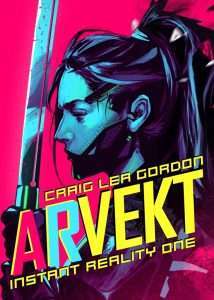 Synopsis: Will the battle for humanity be fought in reality? Or in her mind? Tannis Ord is a black-ops cyborg assassin. A highly-trained human-weapon, dedicated to hunting down the last of the brain hacking syndicates. There’s just one problem…
Synopsis: Will the battle for humanity be fought in reality? Or in her mind? Tannis Ord is a black-ops cyborg assassin. A highly-trained human-weapon, dedicated to hunting down the last of the brain hacking syndicates. There’s just one problem…
Her mind was broken from a psychotic episode. Neural programming erased her trauma, gave her a fresh start. But when an old brain hacker cult resurfaces, and a sentient AI is set to govern the entire human population, she starts seeing things. Horrors that can’t possibly be real… that make no sense… that only she can see. Ix, their AI Guardian, is abducting innocent citizens from the streets in broad daylight. And it’s using the Augmented Reality it has thrown over the world as cover. Is the AI hellbent on humanities destruction? Or is her mind tearing itself apart again?
ARvekt is an explosive story, fusing action and intrigue into a journey full of twists and turns where you won’t know what’s real and what isn’t. If you enjoy books with amazing plots and characters, set in a stunning futuristic world, then input ARvekt into your brain now.
Recommendation: Arvekt is a great example of classic 1980s cyberpunk. If you like ninja cyborgs working for all-powerful super computers with questions of augmented reality. I really enjoyed this book, which had a kind of hyper-kinetic and fascinating characters that charge head on into the reader. I love Tannis and her relationship with Ix as she struggles to figure out whether she’s insane or the only one seeing things clearly. The ending feels like it precludes any sequels but I understand there’s a prequel already out.
Read Arvekt by Craig Lea GordonThe Tronic by Rosie Record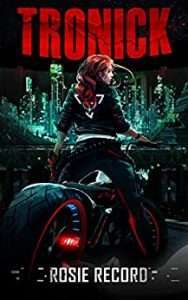 Synopsis: “This is one of the best dystopian novels I’ve read—a great balance of suspenseful action and compelling reflection on how much we are all controlled by our circumstances.”
Synopsis: “This is one of the best dystopian novels I’ve read—a great balance of suspenseful action and compelling reflection on how much we are all controlled by our circumstances.”
This gritty cyberpunk novel introduces readers to a world devastated by systemic corruption, religious extremism, and two opposing forces vying for control of California-Annex. Come dive into the dystopia of tomorrow and follow this anti-hero’s journey to a cliff’s edge.
Too tall to see beyond and impossible to breach, the iconic wall encompassing California-Annex is nothing more than a forgettable reality for generation PW1.6. But while the general populace is addicted to Shine and manipulated by the incessant n-sub messaging, Fiona Tronick is different. She’s seen as a grungy dealer, but she’s really a street operative for The Agency- and she’s always been loyal to her employer. But as civil unrest simmers throughout the Annex, Tronick is confronted with information that makes her question The Agency’s agenda and loyalty. She starts to see the lies go deeper and wider than she could have ever imagined. From Topside Stacks to the underbelly of the Trenches, everything is connected. Connected to her.
Follow Tronick as she rubs shoulders with political leaders in coastal mansions, confronts religious zealots in flooded San Diego, reconnects with her outlaw brother, and taps into the Annex’s gritty underworld in this dystopian-cyberpunk adventure.
Recommendation: A dark and dystopian California separated from the rest of the country by an enormous wall. Rosie Record creates a great protagonist in Fiona Tronik. She is loud, brash, and very entertaining but sadly has one of the most horrifying backstories in fiction. This includes such triggering topics as child abuse, sexual violence, and more. Rosie Record handles the subjects with maturity as well as tact, though, while also delving into multiple other issues like information control as well as philosophy. It is perhaps the most hardcore and punk of the cyberpunk series listed here and all the stronger for it.
Read The Tronic by Rosie RecordBubbles in Space: Tropical Punch by SC Jensen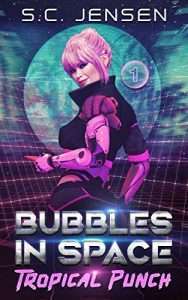 Synopsis: Strippers, drugs, and headless corpses? All in a day’s work for Bubbles Marlowe, HoloCity’s only cyborg detective. Does she like her job? No. Is she good at it? Also no. She can’t afford to be too good. The last time she got curious it cost her a job, a limb, and almost her life. But when a seemingly simple case takes a gruesome turn, and Bubbles discovers a disturbing connection to the cold-case death of an old friend, she is driven to dig deeper. And deeper. Until what she uncovers can never be buried again…
Synopsis: Strippers, drugs, and headless corpses? All in a day’s work for Bubbles Marlowe, HoloCity’s only cyborg detective. Does she like her job? No. Is she good at it? Also no. She can’t afford to be too good. The last time she got curious it cost her a job, a limb, and almost her life. But when a seemingly simple case takes a gruesome turn, and Bubbles discovers a disturbing connection to the cold-case death of an old friend, she is driven to dig deeper. And deeper. Until what she uncovers can never be buried again…
Recommendation: As mentioned, there’s a lot of cyberpunk detective novels. However, are there many cyberpunk detective novels where the protagonist is objectively terrible at her job and has an AI sobriety pig named Hammett? Bubbles in Paradise is a ridiculous affectionate parody of cyberpunk tropes that, nevertheless, works as a serious story. Tropical Punch is a great introduction to Bubbles Marlowe and she’s an amazing character with a great combination of the ridiculous with the surprisingly poignant (as she’s a recovering alcoholic trying to get her life back together).
Read Bubbles in Space: Tropical Punch by SC JensenThe post Another Eight Indie Cyberpunk Novel Recommendations appeared first on Grimdark Magazine.
October 16, 2022
REVIEW: Full Immersion by Gemma Amor
Full Immersion, Gemma Amor’s deeply personal sci-fi horror, opens with a cry for help from the protagonist, Magpie, who pleads to be accepted into a new Virtual Experimental Therapy program to overcome her postpartum depression. Magpie has tried all traditional forms of therapy but still finds herself sinking further into despair. Her letter to the Virtual Experimental Therapy program concludes with three devastating words: “Please help me.”
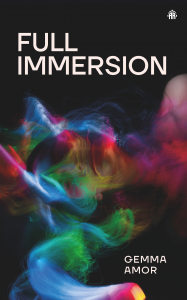 The main part of the novel focuses on Magpie’s treatment in this newly developed program, which involves “full immersion” in a virtual reality environment offering an alternative approach to therapy. The patient works together with a psychologist, who also enters the virtual world. Magpie’s immersion begins with her finding a dead body underneath a bridge, the same bridge in Bristol from which she has repeatedly imagined leaping to her death. To her horror, Magpie realizes that it is her own broken, decaying body in the mud. With this shocking discovery, her treatment begins.
The main part of the novel focuses on Magpie’s treatment in this newly developed program, which involves “full immersion” in a virtual reality environment offering an alternative approach to therapy. The patient works together with a psychologist, who also enters the virtual world. Magpie’s immersion begins with her finding a dead body underneath a bridge, the same bridge in Bristol from which she has repeatedly imagined leaping to her death. To her horror, Magpie realizes that it is her own broken, decaying body in the mud. With this shocking discovery, her treatment begins.
Full Immersion alternates between the first-person narration of Magpie in the virtual world and the third person narration of the laboratory staff as they monitor her progress. The change in tone between Magpie’s intensely emotional narration and the clinical observations of the program staff is rather jarring. To them, Magpie’s depression is an object of scientific study, but to Magpie it consumes all aspects of her life.
As Magpie begins her treatment program, there is a clear separation between the real and virtual worlds. But as the novel progresses, the boundary between the two worlds becomes blurred. Magpie’s experiences in the virtual world are akin to lucid dreaming, i.e., actively recognizing that one is dreaming and seeking to manipulate that dream. Similarly, Magpie gradually recognizes that she is in a virtual world and intuitively understands how to control her environment.
At first the clinical staff is surprised and impressed by Magpie’s ability to manipulate the virtual world. But this surprise gradually transitions to horror as her manipulation crosses over into the physical world.
Full Immersion is, first and foremost, a profound psychological analysis of a person who finds her way back from the deepest depths of postpartum depression. The sci-fi aspects of the story are a great vehicle for bringing Magpie’s mental state vividly to life. The horror elements mostly focus on Silhouette, a shadowy creature who represents the physical manifestation of Magpie’s depression, aggressively consuming everything in its path.
While Full Immersion is a wholly original tale, some aspects of the story reminded me of Haruki Murakami’s masterpiece of magical realism, The Wind-Up Bird Chronicle. Both books make prolific use of avian imagery, e.g., a birdcall as the harbinger of impending doom. More significantly, they both focus on characters who enter alternate mental states on journeys through the darkness of the human psyche toward self-discovery.
The finest books will leave such an indelible impact on the reader that it makes them a changed—and hopefully better—person. Full Immersion is one of those books. Gemma Amor is to be commended for her raw and honest description of postpartum depression. She reminds us that there is always a path out of the darkness.
5/5
Read Full Immersion by Gemma AmorThe post REVIEW: Full Immersion by Gemma Amor appeared first on Grimdark Magazine.
REVIEW: The Rings of Power- Episode Eight
The Rings of Power E8 had to finish the season in a satisfying way. The expectations placed on the Lord of the Rings spin off may have weighed it down like the One Ring around the neck of a hobbit, but the show finally answered some of the many questions that have been asked over the eight episodes and left fans eager for more.
The Rings of Power E8 will not be for everyone. With such a huge audience, it was always going to be impossible to make everyone happy. Especially when the series is based off the history created by Tolkien and with certain characters and even names not being permitted for use from The Silmarillion. The first season of The Rings of Power has been about introducing its audience to a world that is familiar and yet different. There are characters that we have never met before and some who seem to be wearing a different face. It was a difficult task for the showrunners to make its audience care for this time in history but, looking back on the season as a whole, I feel that they have done a good job. The Rings of Power E8 tried a bit too hard with misdirection that was not needed, trying to be a little bit too clever with the reveal of everyone’s favourite villain, Sauron.
When the true reveal comes to light, it all makes sense and requires a rewatch of earlier episodes. The acting is some of the best in the season so far with Sauron acting as Tolkien always described him in this period of time, as the ‘Lord of Gifts’ who flattered and deceived the elves, dwarves, and men to convince them in creating the titular Rings of Power. The show plays a bit fast and loose with some elements of the history of Middle-earth but the decisions make sense. There are more hints at who The Stranger really is, and the episode really sets things up for what could be a very strong season two now that all the pieces are in place and major characters revealed to the audience.
The Harfoots show that halfling strength and bravery we all love when defending their tall and increasingly verbose friend, acting as the heart of the show in a way that would make Tolkien proud. Bravery in the face of seemingly unsurmountable odds is a core element of Lord of the Rings and it is clearly on display in The Rings of Power E8. Galadriel and Elrond grow closer as the future Lady of Lothlorien grows suspicious of her ally Halbrand (a highlight in this episode) and a final shot of Mordor will leave fans eager for the start of season two. The episode focuses on trust. The trust between Galadriel and Elrond as she watches with suspicion as Halbrand grows closer to Celebrimbor. There is also the trust between Nori and The Stranger, as she is adamant that he is a good man, even when he is not so sure himself. Such themes lead to a stronger episode and one that feels very Tolkien and will please most fans of Lord of the Rings.
The Rings of Power E8 is one of the strongest episodes of the season so far. Excellent acting and satisfying answers to the biggest questions mean that the road is clearer than ever for The Rings of Power. This unexpected journey has been a beautiful but bumpy one in comparison to the fantasy behemoth that is House of the Dragon, but there really is something comforting about this return to Middle-earth that no other fantasy series can compare with. It is a show full of heart that seemed to get lost part way through before dragging itself back on track. Finally, the series must have remembered to follow its nose. Imperfect, but beautiful and wholesome; I can’t wait for season two.
Watch The Rings of Power on Amazon Prime.The post REVIEW: The Rings of Power- Episode Eight appeared first on Grimdark Magazine.
October 15, 2022
REVIEW: Beyond a Steel Sky
Beyond a Steel Sky is the follow-up to the classic cyberpunk point and click adventure game Beneath a Steel Sky. I really enjoyed that game and it’s rusted Australian vision of the future as Robert Foster was kidnapped from the Outback where he was living, only to find himself up against a satirical society of upper class twits in a decaying urban hellscape.
 Basically, it was the video game version of the classic film Brazil by Terry Gilliam. Making a sequel to that sort of game was already going to be difficult even with the involvement of the original creator, Charles Cecil. Given the original was created with the involvement of Watchmen co-creator Dave Gibbon, I had the feeling something was going to be missing. Still, I’m always willing to give dystopian science fiction a try.
Basically, it was the video game version of the classic film Brazil by Terry Gilliam. Making a sequel to that sort of game was already going to be difficult even with the involvement of the original creator, Charles Cecil. Given the original was created with the involvement of Watchmen co-creator Dave Gibbon, I had the feeling something was going to be missing. Still, I’m always willing to give dystopian science fiction a try.
My feelings are…mixed.
Beyond a Steel Sky’s premise is Foster is living in the Outback (“The Gap”) with a local family when their son is kidnapped by a group of androids as well as a giant four-legged machine. Following it back to Union City, which has become a megapolis even bigger than its previous incarnation, he discovers everything is now under the control of benevolent-seeming AI. The city looks clean, beautiful, and pristine with all of the citizenry’s needs taken care of. However, there’s a darker undercurrent to things as if kidnapped children wasn’t a big enough tip off.
Foster must assume the identity of a dead sanitation worker named Graham Grundy and solve the riddle of Union City. Where has his friend Joey (now worshiped as a god) gone? Who is kidnapping the children? Why? Also, what is in the drink Spankles that everyone seems to drink and contains 250% of your daily recommended dose of caffeine? Where can I get some? Oh wait, that’s just your average energy drink.
Gameplay wise, the game is basically a 3D adventure puzzle game. You have Foster walk up to things, touch things, take things, poke things, and try to figure out what he needs to do next. None of the puzzles are particularly hard but they can be a little obtuse like the fact you can probably figure out what needs to be lit on fire three or four steps before you actually can do it. The game is also frustratingly easy as you can never really proceed after missing something and this was rather annoying as some more game over states would have been appreciated. Instead, you get not so subtle reminders, “I should probably check X out before going to Y.”
The gameplay sensitivity is also rather troublesome, at least on consoles, because sometimes there’s timed puzzles that you need to move things around about that struggle because it doesn’t register you’re in the right place to do what you want. There’s a hacking minigame but it barely qualifies as a puzzle. There’s usually a blindingly obvious solution where you have to move certain shaped blocks into certain shaped holes about as challenging as an average five- year-old’s puzzle.
Really, the game is almost impossible to lose and if you ever run into trouble then you can just ask the Hint system. It takes about three times (as well as 30 seconds between them) to get it to tell you the answer but never left me stuck. If I had one big complaint, it’s the fact that the “running” speed of Foster is so slow that it really should be the default speed. It made Foster feel like he wasn’t capable of a brisque jog.
The appeal of the game is really the writing and graphics. The writing is still quite crisp and entertaining with Foster always having a witty likable charm to him even when he’s dressing down other characters, especially when he’s dressing down other characters. All the other characters are various stages of jerk or fool, which is what made the original game so enjoyable. The graphics also have an enjoyable comic book style ala Borderlands or Telltale’s Walking Dead that doesn’t require photo-realism but ages very gracefully. The city looks like a cartoonish but beautiful Jetsons-esque utopia in some places as a dingy hellhole in others.
So what brings the game down? Well, the problem is basically the original game was quite fun in its satire. It attacked the super-rich, police brutality, the pointlessness of travel agencies, the exclusiveness of country clubs, and horrible safety conditions in the working class. Nothing that was particularly preachy or incisive but enough that you knew they were highlighting the absurdity of the real world. It was satirical and stronger for the fact it was poking fun at things in the real world.
The premise of Beyond a Steel Sky is that the people of Union City have an oppressive nanny state that provides for all of the food, medicine, shelter, and entertainment you could possibly want. Yeah, okay, that’s not something that exists in the real world. It’s also something that the game attacks as oppressive to the human spirit or something. Which, um, okay, sure. As such, the satire feels pointless as most of us would be willing to deal with the brainwashing and kidnapping versus the threat of freedom from poverty.
In conclusion, Beyond a Steel Sky is an okay adventure game and pretty fun. You don’t need to have enjoyed the previous game to enjoy this one. Unfortunately, the satire and bleak cyberpunk atmosphere of the first game is gone with the criticism of an overbearing socialist technocracy being far removed from most reader’s struggles.
The post REVIEW: Beyond a Steel Sky appeared first on Grimdark Magazine.
October 14, 2022
REVIEW: The Two Doctors Górski by Isaac Fellman
The Two Doctors Górski by Isaac Fellman is an introspective masterpiece of low fantasy, exploring questions of identity, mental illness, and toxic relationships in higher education.
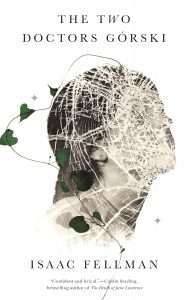 The main character, Annae Hofstader, is a 27-year-old Ph.D. student who escapes an abusive relationship with her thesis advisor at the University of California by transferring to Brandford University in England. As the only female graduate student in her program, Annae feels self- conscious and isolated.
The main character, Annae Hofstader, is a 27-year-old Ph.D. student who escapes an abusive relationship with her thesis advisor at the University of California by transferring to Brandford University in England. As the only female graduate student in her program, Annae feels self- conscious and isolated.
Annae’s field of study is magic, which is viewed as both a science and an art. While her peers focus primarily on botanical applications of magic, Annae hopes to use her magical skills to cure mental illness. To aid in this endeavor, Annae has acquired the ability to enter the consciousness of other people, reading their innermost thoughts. Although she seeks to help others, she often finds herself slipping into nearby minds to escape her own troubles and insecurities.
Annae’s new advisor at Brandford University, Dr. Marec Górski, is highly accomplished in the magical arts, but also heartless and temperamental. Marec’s cruelty runs deep. Wishing to free himself from guilt over his offensive treatment of others, Marec uses his magical skills to excise the benevolent aspects of his personality, creating another Dr. Górski in the form of a homunculus named Ariel. While Marec is a university professor specializing in magic, Ariel becomes a psychologist. With her own research, Annae wishes to span both these fields represented by the two Doctors Górski, using magic-enhanced psychological manipulation to heal mental sickness.
Annae is a complex, multilayered character with a genuine desire to help others. However, she doubts her own abilities and doesn’t want to face the ethical implications of entering other people’s minds—especially without their consent. As a result, her good intentions often result in perilous consequences.
The magic itself in The Two Doctors Górski is treated as just another ordinary field of study, subject to the same pressures as real-world academic research. I am impressed by how Isaac Fellman has interwoven this subtle form of magic throughout a realistic, modern-day academic setting.
The Two Doctors Górski is one of the best examples of dark academia that I’ve had the pleasure of reading. All too often, books labeled as “dark academia” fail to capture a realistic portrait of academic life, with students portrayed as overly self-confident, pretentious, and edgy. In The Two Doctors Górski, Isaac Fellman has captured a more authentic view of the struggles faced by graduate students.
Graduate advisors are in a position of almost unquestioned authority over their students, and unfortunately this authority can be abused. Fellman skillfully captures the psychological impact of such abuse, which ranges from everyday bullying to sexual exploitation.
The Two Doctors Górski also brilliantly addresses the issue of imposter syndrome. As the chair of my university’s graduate program with over 200 Ph.D. students, this is by far the most common issue that I have seen amongst our students. Imposter syndrome—the persistent doubting of one’s own abilities and feeling unworthy of one’s achievements or accolades—has become an almost universal feature of the graduate school experience, especially among female students. On the other side, Marec’s pompous attitude and callous treatment of students is, unfortunately, reflective of some faculty members with overinflated egos.
The Two Doctors Górski is a highly original work of fiction, unlike anything I’ve ever read. The closest comparison I can think of is The Double by Fyodor Dostoevsky, in which the main character encounters his doppelgänger who possesses all the charm and good social skills that he lacks. Dostoevsky’s theme of split identity is clearly mirrored by the title characters in The Two Doctors Górski but is also reflected in a more subtle way with Annae as she leaves her own consciousness to enter the minds of others. This theme is also apparent in the name Annae, which Marec dismisses as just being the plural of Anna.
The author went through his own struggles with identity during and after the writing of this novel, explaining, “I wrote this book before I came out as a trans man, and my own experiences of being seen this way—as someone not a woman, but presenting as one—heighten Górski’s sense of paranoia and dread.”
Isaac Fellman’s well-polished and lyrical prose creates a hauntingly atmospheric mood throughout The Two Doctors Górski. Annae’s ability to enter other people’s minds offers a clever narrative tool for the author to switch points of view amongst various characters. I was particularly moved by the scene in which Fellman gives a physical manifestation of the crippling anxiety experienced by Annae’s classmate, Torquil, and the hollowness that is left behind in the absence of his fears.
Isaac Fellman earns bonus points for his myriad of subtle allusions throughout the book. I particularly appreciate the reference to the indie rock pioneers Neutral Milk Hotel and their opus, “In the Aeroplane Over the Sea,” which serves as Annae’s ringtone and contains a lyric directly relevant to the story: “Anna’s ghost all around / Hear her voice as it’s rolling and ringing through me.”
The Two Doctors Górski is literary fantasy at its finest, a deeply contemplative and multilayered novel that explores the real psychological struggles of identity, imposter syndrome, and the trials of academic life.
5/5
Review originally published in Grimdark Magazine #32
Read The Two Doctors Górski by Isaac FellmanThe post REVIEW: The Two Doctors Górski by Isaac Fellman appeared first on Grimdark Magazine.



